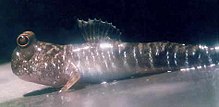Mudskipper
| Mudskippers | |
|---|---|

| |
| Mudskippers in The Gambia | |
| Scientific classification | |
| Kingdom: | |
| Phylum: | |
| Class: | |
| Order: | |
| Family: | |
| Subfamily: | |
| Genera | |
|
Apocryptes | |
Mudskippers are members of the subfamily Oxudercinae (tribe: Periophthalmini[1]), within the family Gobiidae (Gobies). They are completely amphibious fish, uniquely adapted to intertidal habitats, unlike most fish in such habitats, which survive the retreat of the tide by hiding under wet seaweed or in tidal pools.[2] Mudskippers are quite active when out of water, feeding and interacting with one another, for example to defend their territories.
They are found only in tropical and subtropical regions, including all the Indo-Pacific and the Atlantic coast of Africa.
Adaptations
Compared with fully aquatic gobies, these fish present a range of peculiar behavioural and physiological adaptations to an amphibious lifestyle. These include:
- Anatomical and behavioural adaptations that allow them to move effectively on land as well as in the water.[3]
- The ability to breathe through their skin and the lining of their mouth (the mucosa) and throat (the pharynx). This is only possible when the mudskipper is wet, limiting mudskippers to humid habitats and requiring that they keep themselves moist. This mode of breathing, similar to that employed by amphibians, is known as cutaneous air breathing.[2] Another important adaptation that aids breathing are their enlarged gill chambers, where they retain water. These large gill chambers close tightly when the fish is above water, keeping the gills moist, and allowing them to function. They act like a scuba diver's cylinders, and supply oxygen for respiration also while on land.[2]
- Digging of deep burrows in soft sediments that allow the fish to thermoregulate;[4] avoid marine predators during the high tide when the fish and burrow are submerged;[5] and for laying their eggs.[6]

Even when their burrow is submerged, mudskippers maintain an air pocket inside it, which allows them to breathe in conditions of very low oxygen concentration.[7][8][9]
Species
The genus Periophthalmus is by far the most diverse and widespread genus of mudskipper. Seventeen species have been described.[10] Periophthalmus argentilineatus is one of the most widespread and well known species. It can be found in mangrove ecosystems and mudflats of East Africa and Madagascar east through South East Asia to Northern Australia, southeast China and southern Japan, up to Samoa and Tonga Islands.[1] It grows to a length of about 6 in (15 cm) and is a carnivorous opportunist feeder. It feeds on small prey such as small crabs and other arthropods.[11] Another species, Periophthalmus barbarus, is the only oxudercine goby that inhabits the coastal areas of western Africa (Murdy, 1989). Both of these mudskippers are widely traded as aquarium fish, but are very difficult to keep alive in captivity as they require a special tank design and a variety of living prey. Due to their amphibious habits, they are completely unsuited for normal fish tanks.
References
- ^ a b Murdy, E. O. (1989). "A Taxonomic Revision and Cladistic Analysis of the Oxudercine Gobies (Gobiidae: Oxudercinae)". Records of the Australian Museum. Suppl. N°11: 1–93.
- ^ a b c Graham, J. B. (ed.), ed. (1997). Air–breathing Fishes. Evolution, Diversity and Adaptation. San Diego California: Academic Press.
{{cite book}}:|editor=has generic name (help) - ^ Harris, V.A. (1961). "On the locomotion of the mudskipper Periophthalmus koelreuteri (Pallas): Gobiidae". Proceedings of the Zoological Society of London. 134: 107–135.
- ^ Tytler P. & Vaughan T. (1983). "Thermal Ecology of the Mudskippers Periophthalmus koelreuteri (Pallas) and Boleophthalmus boddaerti (Pallas), of Kuwait Bay". Journal of Fish Biology. 23 (3): 327–337. doi:10.1111/j.1095-8649.1983.tb02912.x.
- ^ Sasekumar, A.; Chong, V.C.; Lim, K.H. & Singh, H.R. (1994). "The Fish Community of Matang Mangrove Waters, Malaysia". In Sudara, S.; Wilkinson, C.R.; Chou, L.M. (eds) (ed.). Proceedings, Third ASEAN-Australia Symposium on Living Coastal Resources. Research papers. Bangkok, Thailand: Chulalonghorn University. pp. Vol. 2: 457-464.
{{cite conference}}:|editor=has generic name (help); Unknown parameter|booktitle=ignored (|book-title=suggested) (help)CS1 maint: multiple names: authors list (link) - ^ Brillet, C. (1969). "Etude du comportement constructeur des poissons amphibies Periophthalmidae". Terre et la Vie. 23 (4): 496–520.
- ^
Ishimatsu A., Hishida Y., Takita T., Kanda T., Oikawa S., Takeda T. & Khoo K.H. (1998). "Mudskipper Store Air in Their Burrows". Nature. 391: 237–238. doi:10.1038/34560.
{{cite journal}}: CS1 maint: multiple names: authors list (link) - ^
Ishimatsu A., Takeda T., Kanda T., Oikawa S. & Khoo K.H. (2000). "Burrow environment of mudskippers in Malaysia". Journal of Bioscience. 11 (1, 2): 17–28.
{{cite journal}}: CS1 maint: multiple names: authors list (link) - ^
Lee H.J., Martinez C.A., Hertzberg K.J., Hamilton A.L. & Graham J.B. (2005). "Burrow air phase maintenance and respiration by the mudskipper Scartelaos histophorus (Gobiidae: Oxudercinae)". The Journal of Experimental Biology. 208: 169–177. doi:10.1242/jeb.01361.
{{cite journal}}: CS1 maint: multiple names: authors list (link) - ^ Larson H.K. & Takita T. (2005). "Two new species of Periophthalmus (Teleostei: Gobiidae: Oxudercinae) from northern Australia, and a re-diagnosis of Periophthalmus novaeguineaensis". The Beagle, Records of the Museums and Art Galleries of the Northern Territory. 20: 175–185.
- ^ Milward, N. E. (1974). Studies on the taxonomy, ecology and physiology of Queensland mudskippers (unpubl. Ph D. dissertation ed.). Univ. Of Queensland, Brisbane, Australia.
